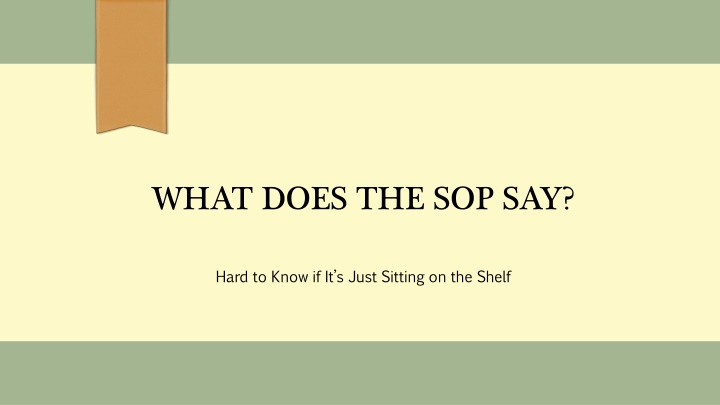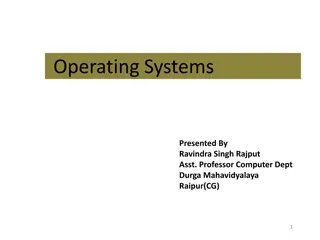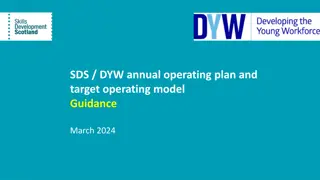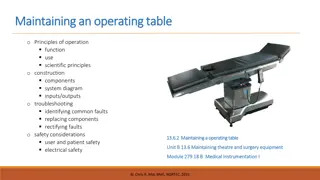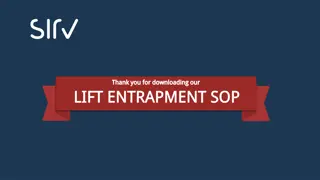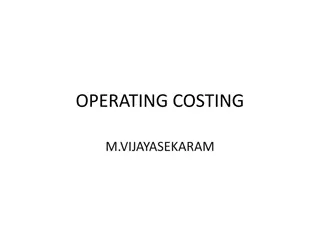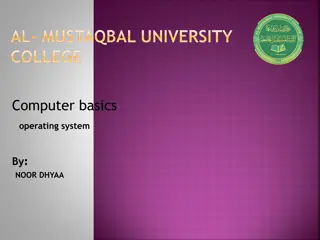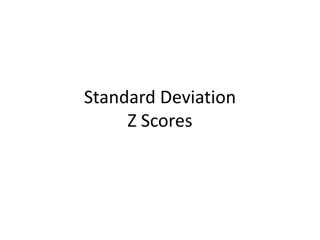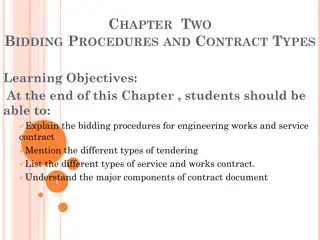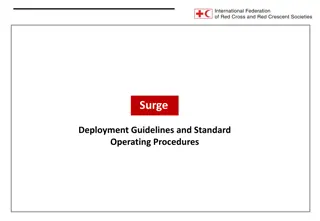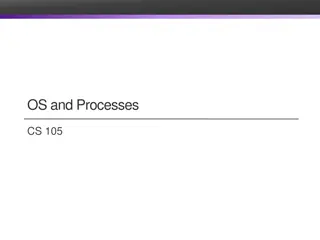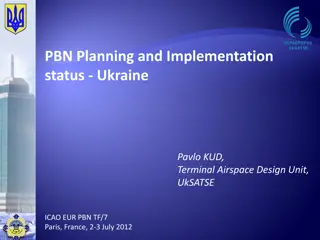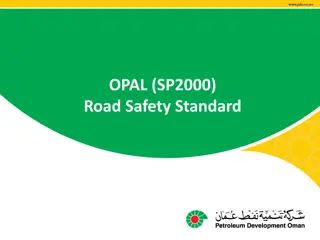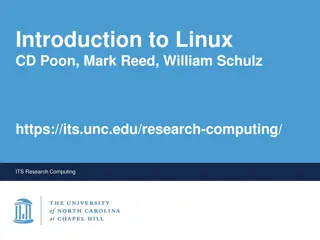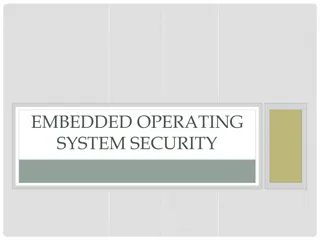Standard Operating Procedures: Importance and Implementation
Learn about the significance of Standard Operating Procedures (SOP) and how they enhance service delivery and operational efficiency across programs. Explore the impact of SOP on meeting targets and ensuring seamless service design.
Download Presentation

Please find below an Image/Link to download the presentation.
The content on the website is provided AS IS for your information and personal use only. It may not be sold, licensed, or shared on other websites without obtaining consent from the author.If you encounter any issues during the download, it is possible that the publisher has removed the file from their server.
You are allowed to download the files provided on this website for personal or commercial use, subject to the condition that they are used lawfully. All files are the property of their respective owners.
The content on the website is provided AS IS for your information and personal use only. It may not be sold, licensed, or shared on other websites without obtaining consent from the author.
E N D
Presentation Transcript
WHAT DOES THE SOP SAY? Hard to Know if It s Just Sitting on the Shelf
Session Objectives Learn about a program s experience with revising SOPs Get general information on creating an SOP Learn how to utilize an SOP Get additional SOP resources
Meet the Presenters Jauneen Maldonado, AEL Director, Workforce Solutions for Tarrant County Consortium Wayne Crandall, PD Specialist, Train PD @ TCALL Krista Mosher, PD Specialist, Train PD @ TCALL
STANDARD OPERATING PROCEDURES (SOP) Presented by: Jauneen Maldonado, AEL Director, WSTC Board
What we will cover Importance of having an SOP How the SOP creates seamless service design across the program How an SOP can help keep you off of a TAP
Background Workforce Solutions for Tarrant County WDB inherited the grant from FWISD on July 1, 2017 along with the TAP. Lack of updated data collection and data entry processes documented and shared with provider staff More than 47 staff with Data Entry Rights in TEAMS Incorrect Fund coding led to targets not being met
Then & Now Set the Bar High Set the Bar High Rise Up Rise Up
Next Steps GET OFF OF THE TAP GET OFF OF THE TAP Held a 2-day planning session with all of the Partners Admin staff and TCALL PD Specialist to work on Standard Operating Procedures and forms Started with the CIP and our PD Specialist to ensure that our processes were aligned to meet our goals.
Next Steps (contd.) Broke out into groups to review each SOP: Data Management PII Recruitment and Marketing Orientation Provided each provider with a binder of all of the SOP s.
Essentials for SOPs Everyone must be involved Everyone needs to see the Big Picture and understand where we are all headed Must include requirements from AEL Grant, AEL Guide, and Assessment Guide Must be willing to make adjustments as you go through the year
Revisions Each Revision is documented and distributed to partners Kept in back of binder until new year SOP is printed and distributed
Data Management SOP Data Entry Weekly; no later than bi-weekly per Assessment Guide Designated IET Data specialist (cross-train for backup) TANF Verification bi-weekly for funding changes Funding Code Report weekly - Supervisor
Finally.. WE ARE OFF OF THE TAP!
SOP TRAINING Ensure Administration is familiar with the SOP Providers included in their on-boarding Signed Receipt from Staff Distribute any Revisions at monthly meetings SOPs are used in our quarterly monitoring of sub-recipients
SOPs Created Data Management and Documentation Recruitment and Marketing Strategy Personally Identifiable Information (PII) Orientation IET and Intensive Professional Development
CHALLENGES 7 Providers making our program seamless Standardized Forms Changing Habits designing a year round service model Helping Staff understand the long-term benefits of having SOPs
Thank you! Jauneen Maldonado 817-804-4225 Jauneen.Maldonado@workforcesolutions.net
WHAT IS A SOP STANDARD OPERATING PROCEDURES Presented by Wayne Crandall and Krista Mosher, PD Specialists, TRAIN PD @ TCALL
What we are going to talk about What is a SOP Why should you have SOPs Who should develop the SOP Who is responsible for implementing SOPs
SOPs What are they? The how of what you do The steps in a process or procedure Standardized guide to help create consistency across an operation A way to monitor/control the flow of work A gauge for accountability
SOPs Why do you need them? Creates a hierarchy of responsibility and accountability Improves communication with staff, providers, contributing stakeholders, and collaborative partners A standard reference/ guide for a process procedure A set of directions for training staff Documentation of the operational parameters 5 of them are required in your contract
The 5 Required SOPs Recruitment and advertising Comprehensive assessment, testing and placement Orientation Customer profile data collection Referral/Co-enrollment across core programs
SOPs vs. MOUs SOP MOU Standard Operating Procedures Memorandum of Understanding Is a procedure specific to your operation that describes the activities necessary to complete tasks. Specify mutually-accepted expectations between two or more people or organizations as they labor together toward a common objective. Any document that is a how to falls into the category of procedures. Common objectives may lead to shared SOPs referred to or embedded in the MOU
SOPs Building them What is it for? What is the projected outcome? Who should create it? Who will use it? How does it fit in to the big picture? What other SOPs affect or are effected by it? From the big book of program SOPs and MOUs Who will monitor its effectiveness?
Sample SOP Template This is a sample template for recording your SOPs. It is NOT report your SOPs to TWC. NOT the official form to
SOPs Building them From start to finish From the general to the specific Define the rigidity/flexibility allowed Define the conditional sets (if then ) Allow for variation Include exemptions Publish and distribute
SOP Checklist see handout When crafting an SOP you should consider the following: What procedures are you standardizing? Who will use the SOP? What other SOP s or MOU s or other processes are affected and how do they work together? What training or base skills/information is needed to follow the SOP? What materials and resources are needed? Have you considered all the rules, policy and guidance (Fed, State and Local) that may apply to the SOP? Is it general or specific to a partner, location or project? Are all the steps included? Are the actions described in enough detail? Are tasks assigned to roles rather than people? Are all conditional laid out in an if then format? Are the decision trees laid out clearly? What is the hierarchy of responsibility and accountability? Are the exceptions well defined? How will your review / revise the SOP? How will you deal with updates to the SOP?
SOPs Using them Every time All the time (SOPs only work when you use them) Availability ( they can t use it if they don t have it) Keep it up to date (Review at least annually or anytime changes occur in the program) 1st question : What does the SOP say? ( if it doesn t say then put it in there)
SOPs Adapt & Adjust Incorporate changes and adjustments Refining Things change Unforeseen circumstances
TRAIN PD @ TCALL THANK YOU!
